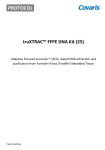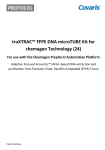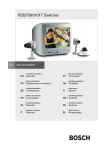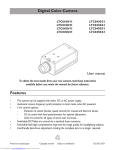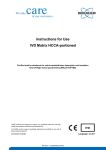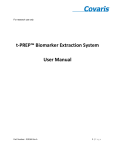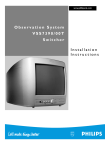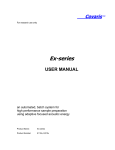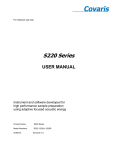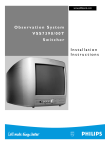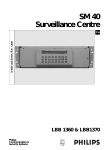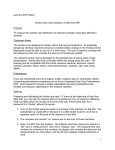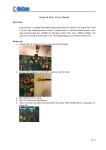Download pn_010317
Transcript
PROTOCOL truXTRAC™ MALDI-TOF Mycobacteria Kit Mycobacteria Colony Sample Preparation Protocol with a Heat Inactivation Step for Analysis on a Bruker Biotyper MALDI-TOF Mass Spectrometer Revision History Part Number 010317 010317 Revision B A Part Number: 010317 Rev B Date: Sept 15, 2015 Patents issued and pending Date Sept 15, 2015 Sept 2, 2015 Description of change Part number changes for starter and reorder kits Initial release Page 1 INTENDED USE This is a Research Use Only protocol. Refer to Covaris document 010157 M220 Manual Rev E for M-series User Manual general instructions and maintenance of the instrument, computer, and software. This protocol is for the sample preparation of Mycobacteria grown on agar plates or tube-slants for MALDI-TOF MS microorganism identification analysis with the Bruker Biotyper mass spectrometer. Colonies should be clearly visible (no inoculum). Collect bacterial colonies using a sterile, disposable 1 μl inoculation loop (~4-8 mg of cells). This Adaptive Focused Acoustics® (AFA™) sample preparation protocol was developed to include a heat inactivation step prior to AFA processing. The heat inactivation conditions of time and temperature are identical to those of the Bruker MycoEx sample preparation protocol. The Bruker database is based on samples that had this initial heat inactivation conditions; and deviation from these initial conditions may adversely impact identification of microorganism. SUMMARY OF AFA OPERATING CONDITIONS AFA Instrument Peak Incident Power M220 40 Watts Duty Factor 50% Cycles per Burst 200 Duration Bath Temperature Processing tube volume 60 seconds 18°C 130 µl Note: Recommended settings are subject to change without notice. Contact Covaris for application to other Covaris Focused-ultrasonicator systems (such as S220, E220, and LE220). See http://covarisinc.com/resources/protocols/ for updates to this document. Part Number: 010317 Rev B Date: Sept 15, 2015 Patents Issued and pending Page 2 COVARIS SUPPLIES Item Materials M220 FocusedUltrasonicator Description M220 with computer and Software Part Number 500295 M220 Starter Kit Item Materials Description truXTRAC MALDI-TOF Mycobacteria Starter Kit Part Number 520194 M220 Holder XTU Holder for 520170 M220 Holder XTU Insert Holder Insert for microTUBE™130 µl Prep Station Prep Station for microTUBE Screw-Cap Centrifuge and Heat Centrifuge and Heat Block Adaptor for microTUBE ScrewBlock Adaptor Cap truXTRAC MALDI-TOF Mycobacteria Kit microTUBE Acoustical Cuvette Reorder Kit Item Materials Description truXTRAC MALDI-TOF Mycobacteria Kit Part Number 520170 microTUBE Acoustical Cuvette microTUBE-130 Glass Beads No-Slit Screw-Cap (25) ADDITIONAL MATERIALS (SUPPLIED BY USER): • • • • • • High purity water (e.g., HPLC/MS grade) Extraction Solvent (50% acetonitrile/35% formic acid/15% H2O). Make up in advance using an amber glass container with screw-cap. Discard if not used after 30 days. For formic acid 98% mass spectrometry grade, use Fluka 94318-250 mL. Laboratory dry block heater (capable of heating to 100°C) Sterile, disposable 1 μl inoculating loops Centrifuge–fixed rotor (18,000 RCF) Variable pipette and tips (2.5 μl and 200 μl) Part Number: 010317 Rev B Date: Sept 15, 2015 Patents Issued and pending Page 3 • MALDI-TOF MS Bruker Biotyper and Mycobacteria database Values mentioned in this Quick Guide are nominal values. The tolerances are as follows: - Temperature +/-2°C - Sample volume +/- 5 µl RISK AND SAFETY INFORMATION The following protocol uses an organic solvent that according to the Globally Harmonized System of Classification and Labeling of Chemicals (GHS) is considered a hazardous chemical. In the manufacturer’s experience, the product has no harmful effect when used and handled according to instructions. This sample preparation protocol for MALDI-TOF analysis may involve exposure to potentially dangerous biological material. Every person working with this protocol is responsible for following all of the necessary health and safety precautions to protect truXTRAC Extraction Solvent is classified as a hazardous chemical. oneself and laboratory personnel. MSDS INFORMATION IS AVAILABLE AT http://covarisinc.com/resources/msds-sheets/ All patient samples and cultures must be considered potentially infective. Only qualified laboratory personnel should perform this protocol. Personnel performing this protocol are responsible for taking and following all the necessary safety precautions for handling potentially pathogenic material. This would include the wearing of appropriate personal protective equipment such as a laboratory coat, safety glasses and gloves. SAMPLE PREPARATION Organisms should be grown on agar until colonies are visually present and experiencing freshly positive growth. Approximately 1 µL should be scraped from the plate using a disposable inoculation loop (4-8 mg). OPERATING CONDITIONS The Covaris AFA process focuses high frequency acoustic energy through vessel walls and into a sample. Such energy is influenced by objects in the acoustic path from the transducer surface to the sample. For example, microscopic particles in the Covaris instrument water bath may scatter the acoustic energy from the sample and reduce processing efficiency. WARNING: Replace water on a daily basis. In addition, if the daily use is high, replace after 100 samples during the day. Part Number: 010317 Rev B Date: Sept 15, 2015 Patents Issued and pending Page 4 For M-Series Focused-ultrasonicators, put the Holder XTU and the Insert XTU microTUBE 130 µl in place and fill the water bath until the water reaches the top of the holder. Allow system to reach temperature. Table 1 - “Mycobacterium protocol with heat inactivation” SonoLab parameters M220 Power Duty Cycle Cycles per burst Time Temperature 40W PIP 50% 200 60 seconds 18°C Prepare Heating Block Dry block heaters should be preset at 100°C. Verify temperature with a calibrated glass thermometer. PROTOCOL WITH HEAT INACTIVATION 1. Turn on the Covaris Focused-ultrasonicator, the associated computer and launch SonoLab 7.2 software. 2. Load the “Mycobacterium protocol with heat inactivation” file in SonoLab if it is not already 3. 4. 5. 6. loaded, or create a new file (section 5.1, Covaris 010157 M220 Manual Rev E). Ensure the water bath has the correct amount of water and that the temperature is in the correct range. Centrifuge the pre-filled Covaris microTUBEs with beads at 3000 RCF for 10 seconds to pellet the beads. Use the Centrifuge and Heat Block adaptors to support the microTUBEs in the centrifuge. The microTUBEs are bar-coded. If you do not utilize the bar-code, manually label the plastic hub of the tubes for sample tracking using an indelible marker. Place up to 4 microTUBEs in the front row of the Prep Station (Figure 1). NOTE: The Prep Station was designed for workflow and has places for (4) four microTUBES to allow the user to keep track of un-processed and processed samples. The station enables one-handed opening of the microTUBE, and the back row of the Prep Station is configured to hold the microTUBE screw cap while adding sample. 7. Open microTUBE Screw-Cap, and place Screw-Cap in designated area of the Prep Station. 8. Add 100 µL of high purity water to each microTUBE. Part Number: 010317 Rev B Date: Sept 15, 2015 Patents Issued and pending Page 5 9. Add 1 µL inoculation loop of sample (4-8 mg) to the microTUBE by shaking the loop until the 10. 11. 12. 13. 14. 15. 16. 17. 18. 19. 20. 21. 22. cells disperse into the water. Place a Screw Cap onto each microTUBE and tighten. Transfer the microTUBEs to the laboratory block heater. Use the blue anodized Centrifuge and Heat Block Adaptors for each tube as necessary to ensure heat transfer. Heat the microTUBEs for 30 minutes at 100°C. Carefully remove the microTUBEs from the laboratory block heater, allow to cool several minutes in the Prep Station. Using the Centrifuge and Heat Block Adaptors as necessary, centrifuge all sample microTUBEs at 18,000 x g for five (5) minutes. Transfer the microTUBE back to the Prep Station and remove the Screw-Cap. Using a pipette, carefully remove 75 µl of water above the beads. Take care not to remove pelleted material that may be above the beads. Add 100 µL of Extraction Solvent (50% acetonitrile/35% formic acid/15% H2O) to each microTUBE. Replace the Screw Cap onto each microTUBE and tighten. Place a microTUBE with sample into the appropriate Covaris instrument and process each sample with AFA by running the “Mycobacterium protocol with heat inactivation” treatment. Once each sample has been processed, place the microTUBE in the second row of the Prep Station. Centrifuge all samples at 18,000 x g for 2 minutes using the Centrifuge and Heat Block Adaptors to support the microTUBEs. Spot 1 µL replicates onto the MALDI target plate or slide. WARNING: All samples should be processed and spotted onto the MALDI-TOF target plate and analyzed within 60 minutes. 23. Follow the manufacturer’s directions for completing the MALDI-TOF MS analysis. For example, Table 2 represents typical scores obtained from culture plates from Mycobacterium smegmatis prepared with both the truXTRAC protocol and with the MycoEx protocol according to manufacturer’s instructions. Part Number: 010317 Rev B Date: Sept 15, 2015 Patents Issued and pending Page 6 Figure 1. Prep Station with microTUBEs and Screw-Caps in use Row 1: microTUBE and Screw-Cap Row 2-4: microTUBEs with Screw-Caps removed TYPICAL OUTPUT READINGS: VARIATION Table 2. Bruker Biotyper Scores* from Mycobacterium smegmatis after two-day culture on Middlebrook agar plates # 1 2 3 4 5 6 Covaris AFA Heat inactivation 2.208 2.187 2.167 2.243 1.990 2.155 Bruker MycoEx 2.259 2.227 2.181 2.210 1.853 1.795 Avg %cv 2.158 4.09 2.088 9.89 *Using Bruker Mycobacteria database version 1.0 Part Number: 010317 Rev B Date: Sept 15, 2015 Patents Issued and pending Page 7









